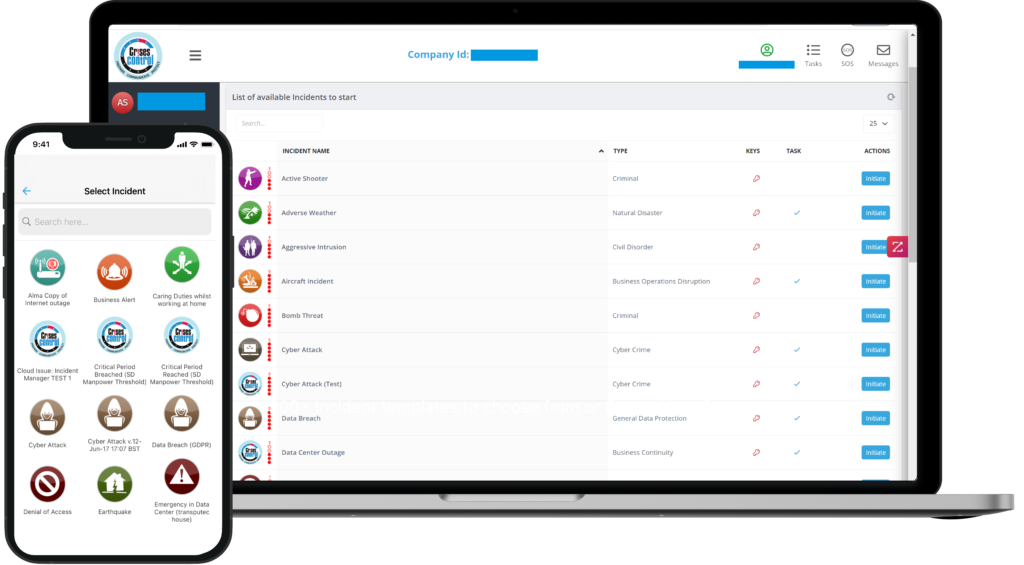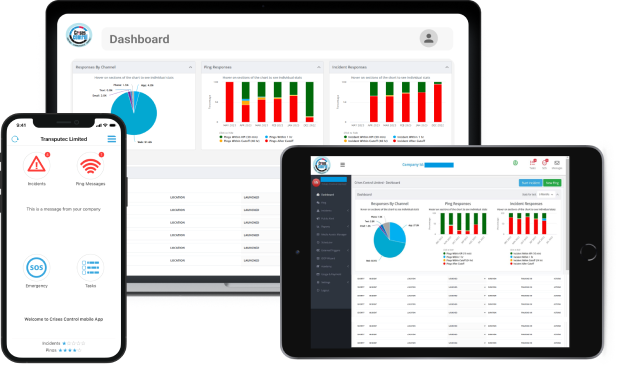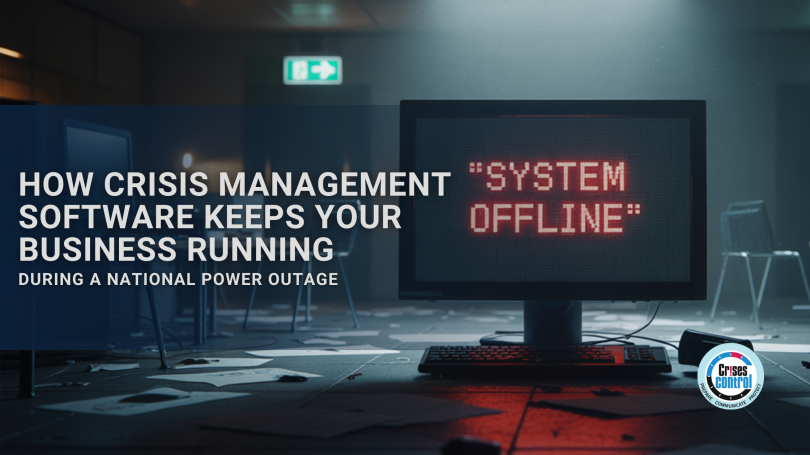Written by Anneri Fourie | Crises Control Executive
Picture this: It’s a regular workday, and suddenly, the lights flicker and go out. Moments later, everything stops working. Your systems crash. Phones stop ringing. Emails go unanswered. Your business is dead in the water, and nobody can reach you. Worse still, your employees are in the dark, literally and figuratively, wondering what happens next.
National power outages are no longer a rare occurrence. Whether it’s a grid failure, a major storm, or an unforeseen disruption, these events can leave businesses exposed. The consequences are immediate: lost productivity, broken communication channels, and a frustrated customer base. For businesses that rely on real-time information and a smooth operation, this kind of downtime is a disaster.
But here’s the good news: it doesn’t have to be this way. With the right crisis management software, your company can stay operational and in control, no matter how bad the power outage gets. This blog will show you how crisis management platforms, like Crises Control, can help you maintain communication, ensure business continuity, and keep your operations running smoothly—even when the lights go out.
The Real Cost of National Power Outages
When the power goes out, it’s not just a minor inconvenience. The costs can be significant, and not just in terms of lost work hours. Consider this: a power outage might stop your core services and production lines, disrupting entire supply chains. When communication breaks down, everyone from employees to clients feels the effects.
A major national power outage can result in:
- Downtime in core services: Your team can’t access critical systems or data, which means no processing, no decision-making, and no production.
- Communication breakdown: Emails, internal chat systems, and phone lines can all go silent. Without communication, coordinating efforts across your organisation becomes impossible.
- Missed customer commitments: Whether it’s a delayed shipment or unmet service delivery, your customers expect consistency, and failing to meet those expectations can harm your reputation.
- IT and data vulnerabilities: A power cut can lead to server crashes or data loss, leaving your business exposed and potentially subject to financial penalties.
Outages are not just about the inconvenience of a dark office, they’re about operational failure, lost revenue, and, in some cases, major safety risks. That’s why old-school contingency measures, like relying on backup generators or manually calling employees, no longer suffice. Today’s businesses need digital-first, real-time solutions.
A Real-World Scenario: Logistics Firm Keeps Delivering Despite Power Grid Failure
In 2022, a logistics company using Crises Control managed to stay operational despite a regional blackout affecting over 250,000 people. They quickly notified their network of drivers, re-routed deliveries based on available fuel stations, and kept teams updated in real-time.
However, recent events have shown that these kinds of disruptions are not isolated to just one area. In April 2025, parts of Spain, Portugal, and southern France faced a massive power outage caused by a cyberattack on the national grid. Millions of people were left without electricity for several hours, with major cities such as Madrid, Barcelona, and Lisbon among the most affected. This outage disrupted business operations, communication, and safety protocols across the region.
Although the cause of the outage is still under investigation, the event clearly highlighted the vulnerabilities of interconnected power grids and the importance of having an effective crisis management solution in place. Businesses in the affected regions were left scrambling to maintain communication, track incidents, and coordinate recovery efforts during this widespread disruption.
The response in such scenarios is critical. Without the right tools, companies risk facing severe operational delays, missed customer commitments, and the inability to respond quickly. However, businesses that are equipped with platforms like Crises Control are able to respond with agility and efficiency, even during the most challenging circumstances.
Crisis Management Software: A Backbone for Operational Resilience
The good news is that modern crisis management software can offer a much-needed solution to ensure you don’t lose control during a power failure. These tools are designed to give you complete visibility, communication, and coordination during any crisis, including power outages.
Here’s how crisis management platforms, like Crises Control, can keep your business afloat even when the power goes out:
1. Multi-Channel Mass Notification System
When the power goes out, you can’t rely on email or internal chat systems. A reliable crisis management software uses multiple communication channels to ensure your messages reach everyone, no matter the situation. Crises Control pushes alerts via:
- SMS: Fast, direct communication via text.
- Voice calls: Automated calls to keep people informed, even when other systems fail.
- Mobile app push notifications: Deliver messages directly to your team’s smartphones.
- Email: If internal systems are up, this still remains a reliable backup.
By using these four channels, Crises Control ensures that your critical communications get through, no matter what. This is crucial during a power failure or network outage, where traditional systems would leave you in the dark.
2. Emergency Communication Without Local Infrastructure
Crises Control is hosted in the cloud, meaning it’s not reliant on your local IT infrastructure. If your servers go down, your communications won’t. As long as your employees have a phone signal or access to mobile data, they can:
- Receive alerts about the status of the business or their responsibilities.
- Acknowledge tasks to show they’re on top of their duties.
- Access response plans to know what to do next.
- Report status or location to keep everyone updated on who’s safe and where the issues are.
This is particularly important for national power outages that impact multiple regions or last for extended periods. The cloud-based nature of Crises Control ensures that employees can stay connected no matter what.
3. Real-Time Situation Monitoring and Task Automation
When the power goes out, you need to make fast, informed decisions. With Crises Control’s advanced incident management workflows, you can:
- Launch predefined crisis response plans tailored to different scenarios (e.g., site-wide, regional outages, or global disruptions).
- Allocate tasks automatically to the right people, ensuring a swift response.
- Track progress in real-time across teams and locations, so you can see exactly where help is needed.
- Escalate issues quickly to senior management when urgent decisions need to be made.
The real-time dashboards provide leadership teams with a full view of the situation, even if they’re working remotely or on the move. This level of visibility helps ensure that the right decisions are made, and your response is coordinated across the organisation.
4. Mobile-First Incident Response
With the Crises Control mobile app, your employees can remain engaged and productive, even when they’re not sitting at their desks. Whether they’re in the field, at home, or working remotely, your team can:
- Report incidents as soon as they happen.
- Receive instructions and updates on the go.
- Stay connected to the team and response plans.
This functionality is vital for businesses like logistics, utilities, and healthcare, where frontline workers need to stay in touch during a crisis. Whether the outage is local or widespread, everyone stays in the loop.

Interested in our Incident Management Software?
Customise your Crisis Incident Management Software to meet your specific needs with our flexible tools & stay connected and informed during the crisis and incident management process
Why Traditional Contingency Plans Are No Longer Enough
Before the digital age, businesses relied on backup generators, physical call trees, and handwritten logs to stay connected during an emergency. But those methods simply aren’t scalable or fast enough to respond to modern crises.
Here’s why traditional plans fall short:
- Scalability: Old-school solutions can’t handle multi-location or multi-team coordination. Today’s businesses are large and complex, and they need a crisis management system that can scale.
- Speed: Manual systems take too long to deploy, especially when time is critical. You need an automated solution that kicks into action immediately.
- Reach: Many traditional methods fail to work in remote or mobile environments. Employees without internet access or desk phones can quickly be left out of the loop.
- Integration: Traditional systems don’t easily integrate with your cloud-based infrastructure or business workflows, which means you’re operating in silos during a crisis.
Crises Control addresses all of these issues. It’s automated, scalable, and designed for today’s mobile, interconnected workforce.
Integrating Crisis Management Software into Your Power Outage Strategy
To prepare your business for a power outage, consider these practical steps:
Identify Vulnerabilities
Map out which systems, locations, or departments are most critical to your business. Identify which ones will be hardest hit by a power failure and need the most attention.
Define Communication Protocols
Set up clear contact channels, group hierarchies, and escalation rules within your crisis management software. Use Crises Control to make sure your messaging is timely and traceable.
Automate Response Plans
Create pre-set playbooks for different crisis scenarios, including national power outages. Test these plans regularly to make sure your response is as quick and efficient as possible.
Train Your Team
Your software is only as good as the people using it. Use Crises Control’s Academy module and run regular blackout simulations to keep your team prepared.
Monitor & Review
After an incident, use Crises Control’s audit logs to assess your response. Identify areas for improvement and make adjustments for the future.
How Crises Control Helps You Stay Operational
Crises Control ensures that your business stays connected, organised, and responsive during national emergencies. Key benefits include:
- Instant, Multi-Channel Communication: Ensure critical messages reach your team, no matter the circumstances.
- Remote Control and Visibility: Monitor and manage incidents from any device, anywhere.
- Reduced Downtime: Maintain productivity and coordination, even during extended outages.
- Compliance and Reporting: Keep accurate records for regulatory compliance and audits.
Explore Crises Control features or schedule a consultation
Conclusion
Power outages are unpredictable, but your response shouldn’t be. By adopting modern crisis management software like Crises Control, you ensure that your business can remain operational, even during the worst disruptions.
Don’t wait until the next outage strikes. Contact us today for a free demo and discover how Crises Control can help your business stay resilient when the lights go out.
Request a FREE Demo

